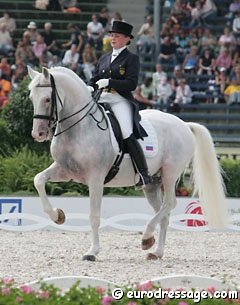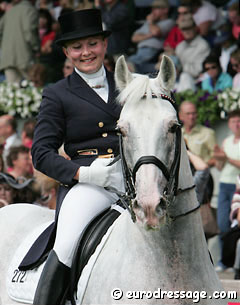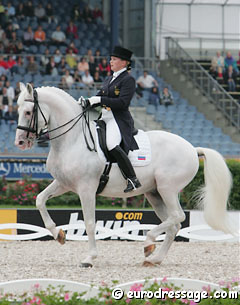
It is a rare situation when one horse can taken an entire breed into modernity and bring centuries of breeding tradition back into the spotlight. The 17-year old Orlov Trotter Balagur has done so! Under the Russian Grand Prix rider Alexandra Korelova, Balagur is one of the world's highest scoring dressage horses of the moment.
An entire tradition and the popularity of this breed now seem to be resting on the white Balagur.
The 18th century is arguably one of the most eventful in European and perhaps in world history. It saw the birth of the United States in 1776; France became a republic following the revolution of 1789; the British Crown Colony of New South Wales in what is today known as Australia started with the establishment of a settlement at Port Jackson on 26 January 1788. This date was later to become the new country's national day, Australia Day. Peter the Great ruled over Russia from 1696 to 1725 carrying out sweeping reforms of "westernisation" and expansion which transformed the largely medieval Tsardom into a powerful Empire and a major European power.
Another interesting and perhaps less well known event also took place in the 18th century – the creation of the Orlov Trotter breed, Russia’s most famous native breed, noted for its fast trot and outstanding stamina. It was developed by Count Alexey Orlov at his Khrenovsky Stud farm in the European part of Russia. Apart from being one of the country’s most able statesmen, prime minister to Catherine the Great and commander-in-chief of the Black Sea fleet, Count Alexey Grigoryevich Orlov (1737–1808) found time to professionally breed sheep, chicken and pigeons. He is credited for creating some 70 animal breeds including the Russian wolfhound. His careful efforts in the area of horse breeding resulted in the "finest race of horses" obtained by crossing Arabian stallions with mares of English, Dutch, Mecklenburg and Danish breeding.
 The ancestor of all Orlov Trotters was the grey Arabian stallion Smetanka (Russian for cream), brought from Turkey by Orlov who had paid for him the unheard of sum of 60,000 roubles. Smetanka had short legs and an unusually long body – due to an extra pair of ribs as it later appeared – which became one of the characteristics of the new breed. Although he only survived a year after he has brought to Russia, he managed to sire four offspring among whom was the stallion Polkan (1778-1793). Polkan was crossed with a Dutch mare which, in 1784, produced the grey stallion Bars I (1784–1808), considered the first Orlov Trotter. He was 162,5 cm high at the withers, possessed a fast trotting gait and featured the beauty and noble bearing typical of the newly created breed. For 17 years Bars I was crossed with different mares and sired eleven stallions that carried his distinguishing characteristics. On the impulse of Count Orlov organised racing began and regular races on the ice of the frozen rivers became the place to be for the Moscow nobility.
The ancestor of all Orlov Trotters was the grey Arabian stallion Smetanka (Russian for cream), brought from Turkey by Orlov who had paid for him the unheard of sum of 60,000 roubles. Smetanka had short legs and an unusually long body – due to an extra pair of ribs as it later appeared – which became one of the characteristics of the new breed. Although he only survived a year after he has brought to Russia, he managed to sire four offspring among whom was the stallion Polkan (1778-1793). Polkan was crossed with a Dutch mare which, in 1784, produced the grey stallion Bars I (1784–1808), considered the first Orlov Trotter. He was 162,5 cm high at the withers, possessed a fast trotting gait and featured the beauty and noble bearing typical of the newly created breed. For 17 years Bars I was crossed with different mares and sired eleven stallions that carried his distinguishing characteristics. On the impulse of Count Orlov organised racing began and regular races on the ice of the frozen rivers became the place to be for the Moscow nobility.
In the 19th century, a Trotting Society was established. Orlov Trotters were valued for their beauty and elegance combined with their speed. When harness racing became widespread at the end of the century, the Orlovs faced intense competition from American-developed Standardbreds, who are generally recognized as less refined but faster than the Orlovs. Eventually Standardbred stallions were crossed with Orlov mares and a new breed, the Russian Trotter, appeared. The possibility of the complete extinction of the Orlovs was a concern in the 20th century because of crossbreeding and mismanagement. However, the breed survived, and today 15 stud farms in Russia and the Ukraine raise Orlov Trotters.
 Horsesport has its very own Orlov Trotter who goes by the name of Balagur and competes in Dressage at the highest level under the saddle of Alexandra Korelova. Balagur begun its long and eventful carrier as a circus horse where, it would seem, his welfare was not the priority of his owners. He was then bought by the mounted police where he remained until the age of ten. He was noticed at a parade by one of Russia’s greatest Dressage riders, the late Elena Petushkova, whose knowledgeable eye detected his great potential for piaffe and passage. Thus followed the FEI World Equestrian Games in Jerez de la Frontera in 2002 and Aachen in 2006, the 2004 Athens Olympic Games, and the European Champioships in Hickstead in 2003 and Hagen in 2005. This year at the FEI World Cup™ Dressage qualifier in Neumünster, Alexandra and Balagur scored a perfect 10 for their piaffe.
Horsesport has its very own Orlov Trotter who goes by the name of Balagur and competes in Dressage at the highest level under the saddle of Alexandra Korelova. Balagur begun its long and eventful carrier as a circus horse where, it would seem, his welfare was not the priority of his owners. He was then bought by the mounted police where he remained until the age of ten. He was noticed at a parade by one of Russia’s greatest Dressage riders, the late Elena Petushkova, whose knowledgeable eye detected his great potential for piaffe and passage. Thus followed the FEI World Equestrian Games in Jerez de la Frontera in 2002 and Aachen in 2006, the 2004 Athens Olympic Games, and the European Champioships in Hickstead in 2003 and Hagen in 2005. This year at the FEI World Cup™ Dressage qualifier in Neumünster, Alexandra and Balagur scored a perfect 10 for their piaffe.
Tradition and modernity at their finest.
Text © FEI
Photos copyrighted: Astrid Appels/Eurodressage - no reproduction allowed
Related Links
Eurodressage Photo Database: Balagur
Alexandra Korelova to Compete at the 2004 Olympics
Eastern European Teams Selected for 2007 European Dressage Championships